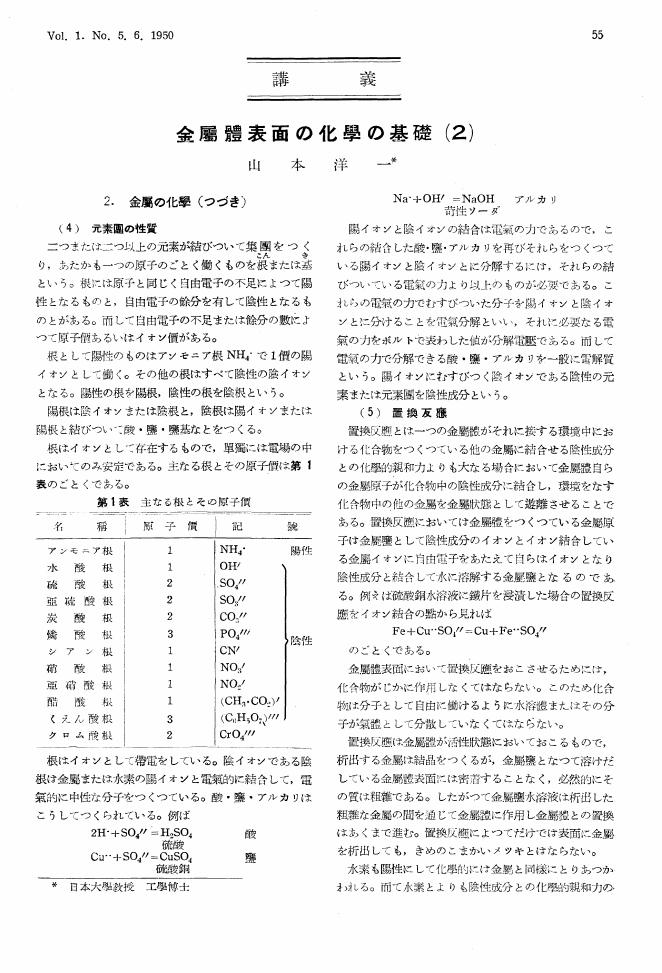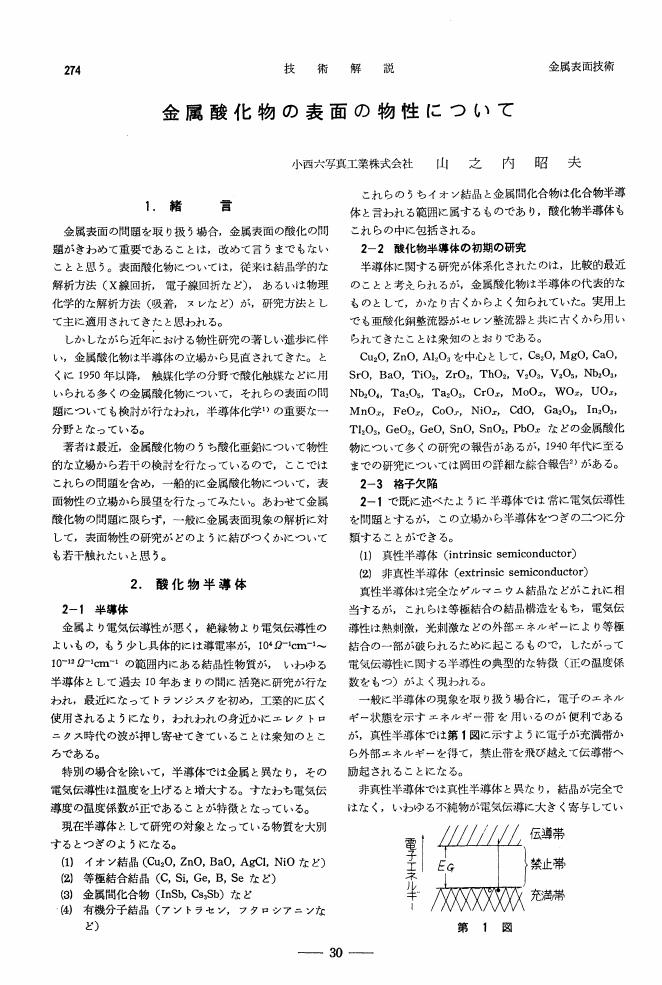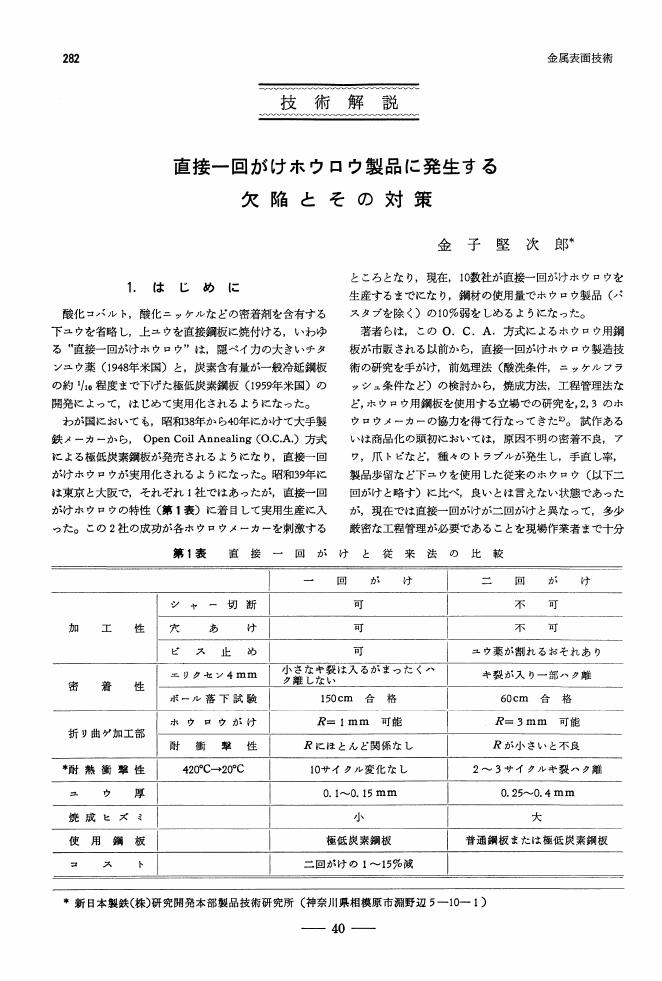1 0 0 0 OA 無彩色系金属上への染料による着色電着塗装
- 著者
- 黒田 孝一 柴田 清勝 桑原 博昭
- 出版者
- 一般社団法人 表面技術協会
- 雑誌
- 金属表面技術 (ISSN:00260614)
- 巻号頁・発行日
- vol.37, no.2, pp.62-66, 1986-02-01 (Released:2009-10-30)
- 参考文献数
- 6
- 被引用文献数
- 1 1
1 0 0 0 OA アルミニウム合金-鉄鋼の耐摩耗性について 表面処理したアルミニウム合金と鉄鋼の組み合わせ
- 著者
- 宮重 昂 多和 田敦 鈴木 良一
- 出版者
- 一般社団法人 表面技術協会
- 雑誌
- 金属表面技術 (ISSN:00260614)
- 巻号頁・発行日
- vol.20, no.12, pp.602-608, 1969-12-20 (Released:2009-10-30)
- 参考文献数
- 9
Surface treatment was conducted on aluminum alloy, ADC 12, by chemical tin plating, electroless nickel plating, electroless nickel plating (hardening), molybdenum disulfide coating on zinc phosphating, and hard anodizing; and on aluminum alloy, ADC 7, by hard anodizing. Then, the surfaces of above treated alloys were combined with steels, FC 15, S 15C, and S 15C (hardening), and subjected to wear tests to study the effects of surface treatment.The results obtained were summarized as follows:(1) Hard anodizing showed the most remarkable effect and electroless nickel plating (hardening) showed the second.(2) The treatment by hard anodizing was easier to conduct on ADC 7 than on ADC 12, and the wear resistance after treatment was higher in the former than in the latter. It was found that the hardness of the surface treated by electroless nickel plating was increased by heat treatment and its wear resistance was also improved. However, little effects were shown by soft and thin films such as treated by molybdenum disulfide coating and chemical tin plating.(3) When 3 kinds of steel materials, FC 15, S 15C, and S 15C (hardening), were combined with surface treated aluminum alloys, the tendency to toward wear resistance was nearly the same.
1 0 0 0 金属印刷について
- 著者
- 佐野 迪
- 出版者
- 一般社団法人 表面技術協会
- 雑誌
- 金属表面技術 (ISSN:00260614)
- 巻号頁・発行日
- vol.14, no.10, pp.391-396, 1963
1 0 0 0 OA アルミニウムの表面処理 (その2)
- 著者
- 中山 孝廉
- 出版者
- 一般社団法人 表面技術協会
- 雑誌
- 金属表面技術 (ISSN:00260614)
- 巻号頁・発行日
- vol.17, no.3, pp.98-102, 1966-03-20 (Released:2009-10-30)
1 0 0 0 表面処理技術の将来を探る座談会:その1 表面処理工業の将来
- 著者
- 石黒 郁夫 橋本 肇 小坂 治男 福元 一郎 小林 義明 山本 壮兵衛 黒田 孝一
- 出版者
- 一般社団法人 表面技術協会
- 雑誌
- 金属表面技術 (ISSN:00260614)
- 巻号頁・発行日
- vol.26, no.11, pp.534-551, 1975
1 0 0 0 OA 全自動化せるボンデライト處理 スプラボンデライジングに就いて
- 著者
- 猪股 武
- 出版者
- 一般社団法人 表面技術協会
- 雑誌
- 金属表面技術 (ISSN:00260614)
- 巻号頁・発行日
- vol.4, no.1, pp.15-19, 1953-02-28 (Released:2009-10-30)
1 0 0 0 OA メッキ液の分析精度管理について
- 著者
- 大森 重夫
- 出版者
- 一般社団法人 表面技術協会
- 雑誌
- 金属表面技術 (ISSN:00260614)
- 巻号頁・発行日
- vol.18, no.12, pp.486-493, 1967-12-20 (Released:2009-10-30)
- 参考文献数
- 8
1 0 0 0 OA 鉱油の熱的性質と冷却性との関係について 「鉱油の冷却効果に関する研究」(第3報)
- 著者
- 原 謙次郎
- 出版者
- 一般社団法人 表面技術協会
- 雑誌
- 金属表面技術 (ISSN:00260614)
- 巻号頁・発行日
- vol.10, no.5, pp.194-199, 1959-05-20 (Released:2009-10-30)
- 参考文献数
- 26
The relation between the quenching properties and thermal properties-specific heat, evaporation heat, thermal conductivity and vapor pressure, etc.-was investigated for mineral oils and known hydrocarbons of low molecular weight.The quenching properties of mineral oils are better when the specific heat and the thermal conductivity are largger, and the evaporation heat and vapor pressure smaller, but each cannot explain perfectly the three stages of quenching curves.T1 is dependent linearly on the critical temperature. The critical temperature, dry point, initial boiling point, viscosity and surfactant qualities controll the quenching properties.
1 0 0 0 OA 金屬體表面の化學の基礎 (2)
- 著者
- 山本 洋一
- 出版者
- 一般社団法人 表面技術協会
- 雑誌
- 金属表面技術 (ISSN:00260614)
- 巻号頁・発行日
- vol.1, no.5-6, pp.55-58, 1950-12-01 (Released:2009-10-30)
1 0 0 0 OA 航空宇宙における接着と今後の問題点
- 著者
- 中尾 一宗
- 出版者
- 一般社団法人 表面技術協会
- 雑誌
- 金属表面技術 (ISSN:00260614)
- 巻号頁・発行日
- vol.37, no.9, pp.534-544, 1986-09-01 (Released:2009-10-30)
- 参考文献数
- 33
- 被引用文献数
- 1 1
1 0 0 0 OA 鉄の黒染め法
- 著者
- 中野 俊介
- 出版者
- 一般社団法人 表面技術協会
- 雑誌
- 金属表面技術 (ISSN:00260614)
- 巻号頁・発行日
- vol.6, no.4, pp.160-163, 1955-07-20 (Released:2009-10-30)
1 0 0 0 OA プラズマ重合膜
- 著者
- 長田 義仁 太田 文彦
- 出版者
- 一般社団法人 表面技術協会
- 雑誌
- 金属表面技術 (ISSN:00260614)
- 巻号頁・発行日
- vol.36, no.11, pp.434-441, 1985-11-01 (Released:2009-10-30)
- 参考文献数
- 65
- 被引用文献数
- 1
1 0 0 0 直接一回がけホウロウ製品に発生する欠陥とその対策
- 著者
- 金子 堅次郎
- 出版者
- 一般社団法人 表面技術協会
- 雑誌
- 金属表面技術 (ISSN:00260614)
- 巻号頁・発行日
- vol.23, no.5, pp.282-291, 1972
- 被引用文献数
- 1
1 0 0 0 OA 金属酸化物の表面の物性について
- 著者
- 山之内 昭夫
- 出版者
- 一般社団法人 表面技術協会
- 雑誌
- 金属表面技術 (ISSN:00260614)
- 巻号頁・発行日
- vol.14, no.7, pp.274-280, 1963-07-20 (Released:2009-10-30)
- 参考文献数
- 29
1 0 0 0 OA エッチングの基礎化学
- 著者
- 加藤 正義
- 出版者
- 一般社団法人 表面技術協会
- 雑誌
- 金属表面技術 (ISSN:00260614)
- 巻号頁・発行日
- vol.38, no.5, pp.172-179, 1987-05-01 (Released:2009-10-30)
- 参考文献数
- 25
- 被引用文献数
- 1 1
1 0 0 0 OA 乾燥工程の問題点
- 著者
- 井上 正良
- 出版者
- 一般社団法人 表面技術協会
- 雑誌
- 金属表面技術 (ISSN:00260614)
- 巻号頁・発行日
- vol.11, no.10, pp.487-490, 1960-10-20 (Released:2009-10-30)
- 参考文献数
- 5
1 0 0 0 OA 金属の電析におよぼす磁場の影響
- 著者
- 千葉 淳
- 出版者
- 一般社団法人 表面技術協会
- 雑誌
- 金属表面技術 (ISSN:00260614)
- 巻号頁・発行日
- vol.39, no.3, pp.106-112, 1988-03-01 (Released:2009-10-30)
- 参考文献数
- 72
The study of magnetic field effects is a relatively new branch of electrochemistry, and although it has grown rapidly in recent years, literature is still fragmentary. Whether or not magnetic field effects are exerted on metals, or on electrolytes, or on both is unknown. The present state of understanding of the effect exerted by magnetic fields on electrodeposition of metals is reviewed. Experimental data have disclosed interesting phenomena. Particular emphasis is placed on the effects of combined electrical and magnetic fields on the qualities and properties of electroplated metals, electrolyte properties, mass transport, electrode kinetics and metal finishing.
1 0 0 0 OA 銅, 銀の電析におよぼす超音波照射の効果
- 著者
- 大野 湶
- 出版者
- 一般社団法人 表面技術協会
- 雑誌
- 金属表面技術 (ISSN:00260614)
- 巻号頁・発行日
- vol.24, no.9, pp.512-516, 1973-09-01 (Released:2009-10-30)
- 参考文献数
- 7
- 被引用文献数
- 1 1
Studies were made on the electrodepositions of copper from sulfate or cyanide baths and silver from cyanide bath under ultrasonic vibration. Discussions were made on the difference between presence and absence of ultrasonic vibration on the current-potential curves and the current efficiency-current density curves. It was observed that polarization was appreciably decreased owing to the reduction of diffusion polarization by the application of ultrasonic vibration. It was also observed that surface roughness and grain size of the deposited layer were improved by its application. These effects were particularly remarkable in silver deposition from cyanide baths, where the current density for operation was considerably increased under ultrasonic vibration for reducing the deposition time.
1 0 0 0 OA 直接一回がけホウロウ製品に発生する欠陥とその対策
- 著者
- 金子 堅次郎
- 出版者
- 一般社団法人 表面技術協会
- 雑誌
- 金属表面技術 (ISSN:00260614)
- 巻号頁・発行日
- vol.23, no.5, pp.282-291, 1972-05-01 (Released:2009-10-30)
- 参考文献数
- 18
- 被引用文献数
- 2 1
1 0 0 0 最近の液体ホーニング加工の趨勢
- 著者
- 諏訪 誠
- 出版者
- The Surface Finishing Society of Japan
- 雑誌
- 金属表面技術 (ISSN:00260614)
- 巻号頁・発行日
- vol.16, no.7, pp.314-322, 1965











